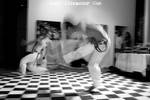ShopDreamUp AI ArtDreamUp
Deviation Actions
R
is for
Rear Curtain Sync
Rear curtain sync is one of the standard flash synchronization modes, or points at which the flash fires. In rear curtain sync, the camera coincides the firing of the flash with the moment at which the shutter begins to close. With a relatively slow exposure and moving subject, this creates a look of a trail of blur, with a sharply-focused subject at the end.



S
is for
Single Lens Reflex
Single lens reflex, or SLR, cameras are a topic that most of you are probably familiar with, but it's still one that I'm approached about often by people wondering what exactly it means.
In a single lens reflex camera, the image you see through the viewfinder is the same as the one the sensor is receiving from the lens; light comes in through the lens, and is bounced to the viewfinder by a pentaprism or mirrors. Obviously, they're meant for taking pictures with the camera at eye level, since you need the camera on your face to focus and frame the shot accurately. The advantage of an SLR over a viewfinder camera - where you're seeing through a second lens - is that SLRs lend themselves more readily to interchangeable lenses and zoom lenses (since a viewfinder would need to also be changed to correct for focal length), and don't have parallax errors - differences in the relative placement of two objects as the distance or focus changes.
:thumb75049343:


T
is for
Twin Lens Reflex
If you don't want the long exposure of a pinhole camera and can't afford a 12mm-lensed film camera like a Voigtlander Bessa-L, but still don't want to focus a camera at eye-level for fear of making your subject uneasy, a TLR - twin lens reflex camera is right for you! The fact that they look retro-badass doesn't hurt their popularity either.
A TLR camera has two lenses - one to take the photo with and one to focus with. The lenses are vertically arranged and coupled, meaning that when you focus the top lens it also focuses the bottom lens that exposes the film. Instead of a viewfinder behind the camera, TLRs usually have a pop-up hood with light through the top lens being sent to it by a mirror, allowing you to frame and focus while holding the camera at waist-level.



U
is for
Ultraviolet
Ultraviolet radiation is not visible to the naked eye, but it can cause defects in photos - particularly haze on distantly-focused images and bluish tint on images taken at high altitudes. UV filters fix those skews, and are fairly cheap and very common - a lot of photographers keep one on their lens just to protect the optical glass from scratches.
Thumbs unrelated, but purple.
:thumb140383478:


Beasts
Keeping this shortish: A while back my prime wife @madnessism started a fun little collective over to the side called The Beasts of AI and I've been a part of it for a couple months. We're mostly twitter active, but because of the drama around twitter currently some of us are migrating some work over to DA to get new eyes on it. I didn't want the baggage of this account tied to it (and will not be active in any sense of the term apart from posting my work) so if you want to check out my stuff drop me a watch on @exquisitest. You can also check out some of our early-adopter comrades at @artistficially, @king0lightai and @L3VEL7 - and eventually we'll be setting up @thebeastsofai as a group to collect all our stuff in one space. Check us out @ thebeastsofai on twitter too - we run some neat initiatives. I haven't talked much about my life as an artist after my health issues in 2017, but I've had limited ability to create since then. This is why I'm embracing AI and I view it largely as
A Check-In
I'm Not "Back"
So don't get excited. I just know this is a convenient way to broadcast an update to y'all on where life has led me. I'm still not around much, if at all. I do check my messages maybe once a week and pop on the chat network when I get a snow day at work. I'm creating, but it's not meant for y'all. :pringles:
So illness sucks. That's not up for debate. All types of illness suck. A cold sucks. Scrambled nerves suck. Depression sucks. Vague autoimmune diarrhea sucks. Abscessed molars suck. Herpes sucks. (Not crotchpox. The shingles. I'm less sexually active than a Buddhist nun.) Then it all gets better. Medication juggling is an
One Last Update
Words?
So by now you've probably noticed I'm not around much. It happens.
My life has gravitated elsewhere. "Elsewhere" is this weird and wonderful place of reading tarot semi-professionally, growing okra, playing cards every Wednesday with my 78-year-old great aunt Annette over a bottle of moonshine, owning roughly half of a rapidly growing art-oriented web startup, and trying to find a local beer I don't hate since I've moved cross-country and they don't sell my brand here.
It isn't that I dislike DA. It isn't that my experiences here weren't important, or fun most of the time. The place just has a lot of memories, some good and some terr
Choosing Paints, Part II: HEAVY METAL HEXAGRAMS
Trad Basics Week
Re-Introduction
In the previous installment, Choosing Paints, Part I: Fat and ... Translucent?, we discussed picking your first paint, monochromatic painting and the two-colour and Zorn palettes. For 3300 words. And you thought that was enough learning. :evillaugh:
What we're trying to prevent: Bad life choices, and unsaleable art that leads to the ramen diet.
Today we're going to go over the basic palette of six colours as a launching point for artistic success. These tips apply to all painterly media - oils, acrylics, watercolours, gouache, pastel, you name it and it fits. Let's start with the dry stuff:
The Six Colour
© 2010 - 2024 isthisthingstillon
Comments3
Join the community to add your comment. Already a deviant? Log In
What's the disadvantage of SLRs then?